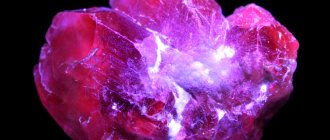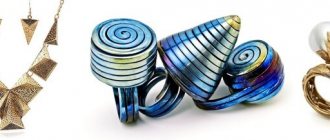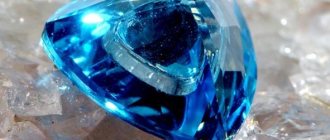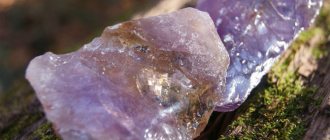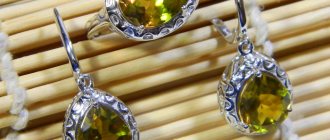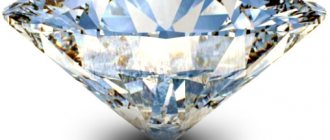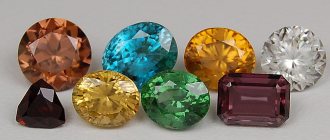What is glass ceramic
Sitall is a glass crystalline material. It was synthesized in laboratory conditions and its composition replicates aluminosilicate glass. Its natural analogue is obsidian volcanic glass.
A modern modification is nanoalloy. Consists of SiO2 and Al2O3 - the basic components of most natural jewelry stones.
Faceted stones
The technology allows you to create stones of any transparency, color, size or purpose. Based on these characteristics, the classification distinguishes jewelry material, ceramics and slag ceramics.
| Density | 2400-2950 kg/cub.m |
| Flexural strength | 70-350 MPa |
| Temporary resistance | 112-161 MPa |
| Water absorption | 0.01% |
| Electric strength | 25-75 MV/m |
| Heat resistance | up to 1000 °C |
| Mohs hardness | 6.5-7 units |
| Special properties | transparent, magnetic, semiconductor, radiotransparent |
What kind of stone is ametrine?
The name "amethrine" consists of two parts: "ameth" - from purple amethyst and "rin" - from golden citrine. A unique gem combines the properties of two different stones. It belongs to rare earth minerals; finding it is considered great luck for a geologist.
Ametrine is a representative of the group of microcrystalline quartz rocks. The presence of the qualities of citrine and amethyst gives it high durability, which is so valued among jewelers who love hard stones. In addition to density, craftsmen are attracted by the breadth of possibilities in working with crystal, allowing them to create works of art.
In addition to ametrine, the crystal is called “bolivianite” due to the fact that the first and main deposit is located in Bolivia.
Variety
The color of the mineral is distributed unevenly. The color of ametrine is:
- golden with purple;
- burgundy-yellow with purple;
- violet-lilac with honey;
- sunny with purple streaks;
- violet-lilac with peach.
Each definition emphasizes the duality of the gem.
Sunny is a rare type of ametrine. Shimmering with golden facets, it gives a luxurious look to any decoration and is in high demand. There is very little of it in nature. To obtain golden ametrine artificially, use:
- Heating the violet crystal or irradiating it with special lamps. As a result, the structure of the gem changes, it becomes lemon yellow.
- Growing crystals of the desired color and size in laboratories under specially created temperature and water conditions. This type of ametrine is called hydrothermal or synthetic.
Watch the video to see how ametrine is classified by color:
History of the stone
Sitall is a product whose creation history is ambiguous.
Russia and the USA dispute the right to be considered the “parent” of the stone:
- American Donald Stuckey developed the technology in 1957. The company that created the crystals called the material pyroceram.
- In the Soviet Union, the development of glass ceramics was carried out by a group of scientists led by Isaac Ilyich Kitaigorodsky. He came up with the idea of using metallurgical waste (blast furnace slag) as a raw material for stone production.
He also introduced the concept of “ceramic glass” into scientific use. According to one version, it is a hybrid of “glass” and “crystal”. According to another, the term is derived from the names of the chemical elements that form the crystal: sicilium (silicon) and aluminum.
Properties of the stone
Sitall is glass-like crystals. But their properties are radically different from “glass”.
Characteristics of the stone:
- hardness on the Mohs scale – 6.5–7;
- density – 2.4-2.9 g/cm3;
- melts at 1000 °C; in some types of crystals it is higher.
Other qualities of the stone are provided by the chemical composition and structure:
- Heat resistance is guaranteed by lithium, aluminum plus mineral raw materials (mullite, eucryptite, spinel) in the crystals.
- Unlike natural stones, glass ceramic has zero porosity.
- The ultra-fine grain makes it an electrical insulator.
- Increased density creates the same thermal conductivity.
- The stone is chemical resistant.
The transparency of the crystals is almost perfect: their length is measured in hundredths of a millimeter, which is half the wavelength perceived by the human eye. Jewelers appreciate this.
Properties of industrial glass ceramics (to enlarge, click on the picture)
Physical and chemical properties
Ametrine is a stone that has a number of physical and chemical properties:
- The color is double, violet with a transition to yellow. The shades of colors and their characteristics may vary depending on the place of extraction of nuggets and the substances included in the composition;
- Mohs hardness index - 7 points;
- characteristic glassy sheen that adds brightness;
- names: ametrine, bolivianite, amethyst-citrine, two-color amethyst;
- can be transparent or translucent;
- formed in the form of prismatic crystals;
- characterized by a chaotic distribution of colors according to a zonal or pyramidal type.
The saturation of both colors depends on the impurities: deep purple, lilac, lemon, golden yellow with an orange tint, etc.
How to get crystals
The manufacturing technology of glass ceramics is almost the same as that of glass or glass ceramics. The property of glass to crystallize is taken as a basis.
Stages of stone production:
- A “source” is prepared—a charge consisting of one or more nucleators (nucleus-forming substances-clarifiers). They determine the number of central elements for further crystallization. For every mm3 there are billions of such substances.
- The charge melts. This process is two-phase. First, the centers of the crystal crystallize, then the temperature is increased so that they are overgrown with new aggregates.
- The molten mass is poured into molds.
- The resulting stone is cooled.
The result is fine-crystalline glass ceramics.
Unlike the production of glass through spontaneous crystallization, with glass ceramics everything is ordered and controlled.
Sitall production technology was used to mold ruby sital glass for the stars on the Spasskaya Tower of the Moscow Kremlin.
Jewelry
Obtaining stone for jewelry became possible in the new millennium, with the advent of nanotechnology. Initially, he was supposed to copy sapphires and emeralds. However, today they create glass ceramic samples of any color with predetermined dimensions.
London glassware
Types of stone
Dozens of types of jewelry glass ceramics have been obtained. The main ones are:
- ametrine – copies a two-color rare expensive stone (a mixture of amethyst and citrine);
- Madeira citrine;
- tourmaline – the Paraiba variety is especially good;
- tanzanite;
- garnet trillion;
- London glassware;
- sultanite
Nanosynthetics imitate any natural stones, but they are cleaner and more transparent than natural ones.
Product range
The strength of nano-alloys is such that jewelers create a full range of jewelry - from pendants to massive necklaces:
- The stones are framed in silver or gold and combined with white or colored cubic zirconia.
- The style of the products allows you to choose jewelry with glass ceramics for all occasions: for the office, for a walk or for a prestigious reception.
- For daytime outings, a palette that imitates opaque stones is appropriate: opal, cacholong, agate, turquoise, and others.
Sitall in jewelry
Sitalls are super strong. Some caution will be required if combined in a product with cubic zirconia. The latter are more vulnerable.
Price
The synthesized material is financially accessible to everyone. The cost of the jewelry is determined more by the material of the frame.
Prices of Russian manufacturers (thousand rubles):
- silver earrings with sitall – 2.3–4.5;
- silver ring – 3.4–6.7;
- gold earrings – 34–45;
- gold ring – 31–48.
The terms “ceramic glass” and “nano metal” are equivalent in the jewelry industry. Both options are used on the tags or in the description.
At the same time, the most expensive ones are red “ruby” crystals. Next come blue, blue glass-ceramic (imitating aquamarine), and lilac stones. However, the difference in the price of inserts does not exceed a couple of tens of percent.
Other uses
Citaals are not only an affordable analogue to precious jewelry raw materials. Artificial stone is used in practical, “mundane” areas:
- Mechanical engineering . The properties of glass ceramics are regulated by supplementing the composition with the necessary elements. For example, raw materials modified with perlite or dolomite become a reliable electrical insulator. Copper or silver increases sensitivity to photochemical processes. Sitall coating of metal parts makes them beautiful and invulnerable to corrosion.
- Optics . Raw materials with additives are quite transparent, so they are used in the manufacture of mirrors, lenses, light filters and a similar range.
- Oil Gas . Sitall pipes are ordered by companies for the extraction, processing, and transportation of raw materials. They have increased thermal and mechanical wear resistance. The material is durable and reliable, which is important in the harsh climate of Siberia or the Far North, when delivering raw materials over a thousand kilometers.
- Electronics . In radio electronics, crystals are used as dielectric insulation of microcircuits.
- Aviation . Glass ceramics based on them are a material for rocket fairings.
- Construction . A popular material for new generation floors is glass marble. Its consumer characteristics are beyond praise: unpretentious, does not wear out for decades.
- Medicine . In dentistry, crystals have found application as a material for fillings and dentures.
- Household sphere . Ceramic glassware and other containers are even suitable for microwave ovens.
Citall blanks
In these areas, various grades of ceramic or slag ceramic are used: lithium, boron-barium, magnesium, titanium, and others. A new trend is slag foam.
In the Ostankino Tower, the floor is made of this transparent glass-crystalline material, which is not inferior in strength to metal, and is built into separate elements into a regular floor. Each of these blocks is designed to support a weight of up to 10 tons.
Glass floor in the Ostankino tower
Advantages of synthetic stone
The advantages of synthetic crystals in industry or other sectors are not in dispute.
Their use has sparked controversy in the beauty industry. But here, too, the glass ceramic stone has many fans.
Jewelry with Sitall
The advantages of laboratory-created crystals are obvious:
- Outwardly indistinguishable from natural ones, they look natural, expensive, and chic.
- In terms of physical parameters - purity, resistance to external influences, etc. - they are superior to natural ones.
- Sitall products do not require special care or caution when using. Can last forever.
- They cost tens to hundreds of times lower than their natural counterparts.
Typical examples:
- Morganite . This pink beryl in its natural form is often cloudy and discolored even in the sun. Due to the presence of radiation, large products are not made from it. At the same time, the cost is prohibitive. Sitall glassite is transparent and indifferent to temperature. There is no talk about radiation. A beautiful peach nanocrystal with a slight haze is transformed into a cushion.
- Paraiba tourmaline . Natural stone is very rare, expensive, but almost always far from ideal. Paraiba sitalla has a bright, thick turquoise and blue color. Extraordinary color iridescence appears even at dusk. This quality gave rise to the names of the crystal - electric or neon.
- Seatall London . Copy of smoky blue-gray topaz. But it does not turn pale or become chaotically spotted in the sun.
- Sultanite . This sital crystal has a more distinct color iridescence than a natural one. Not afraid of the sun.
Citales in jewelry are spectacular with white or rose gold. They look expensive, so jewelry with them is worn with luxury clothing.
Citales are superior in physical and aesthetic parameters to cubic zirconia, Swarovski crystals, and other “old” artificial analogues. They are more durable and do not fade. After cutting or other processing, even large crystals retain their shine and color.
Scope of application and products made of glass ceramics
Sitall was invented back in the 70s of the last century, but it began to be used in jewelry relatively recently. Previously, it was not used for jewelry due to the fact that metallurgical waste was used to create it. This did not add beauty to the stones, and the colors of the crystals were not suitable for inserts. Some samples were used in the production of facing tiles until 1970. The situation changed when beige stones appeared, suitable for inlay into jewelry.
Sitall has only recently begun to be used in jewelry.
Since glass-ceramic can withstand high pressure and temperature, it is used for scales or substrates of microcircuits. The artificial mineral is also widely used in astronomical optics. It does not change shape when exposed to heat, therefore it is indispensable in optical elements.
Sitall is widely used in various industries. One of them is mechanical engineering. Here the stones are used to coat metal parts. This gives the product shine and protects against corrosion.
Another industry where glass ceramic is used is oil refining. Sitall pipes are made from the material. They are resistant to high temperatures and mechanical stress, which guarantees their reliability, which is necessary in this field.
Quite often, glass ceramic is used in dentistry. The stones are durable, wear-resistant, have good structure and composition, which is why dental crowns are made from them.
In the household sector, aluminosilicate glass is used to make pots, pans and microwave containers. Sitall is used to make glass marble, which is used in construction to create floors. This material has high performance properties. Interestingly, the floor of the Ostankino TV tower is made of it at an altitude of more than 300 meters. It can withstand a weight of several tons, so there is no need to be afraid that the glass inserts will be damaged if several people stand on it.
Modern jewelers use glass ceramic as a substitute for precious stones. Jewelry and other beautiful objects are made with it. If you choose the right stone, then any thing will shine and shimmer in the sun. Among the jewelry with sitall stones you can find:
- rings and rings for men and women;
- pendants;
- bracelets;
- brooches;
- cufflinks;
- earrings;
- necklaces, etc.
Ring with a Sitall stone
All these products can be a worthy replacement for jewelry with natural precious stones, and their cost will be much lower.
Magical or not?
Sitalls are grown by humans, so they have no healing or magical properties.
But there are advantages to this. Intrigues or “whims” on the part of the stone are excluded. The most powerful sorcerers or other ill-wishers cannot charge it to the detriment of the owner.
Finally, you can choose and wear jewelry as you wish: sital suits everyone, regardless of their zodiac sign.
| Zodiac sign | Compatibility |
| Aries | + |
| Taurus | + |
| Twins | + |
| Cancer | + |
| a lion | + |
| Virgo | + |
| Scales | + |
| Scorpion | + |
| Sagittarius | + |
| Capricorn | + |
| Aquarius | + |
| Fish | + |
(“+++” – fits perfectly, “+” – can be worn, “-” – is strictly contraindicated).
Ametrine and the signs of the Zodiac
Not the entire zodiac circle can cope with the strong energy of ametrine. Who is the mystical gem suitable for according to their zodiac sign:
- Aries and Leo , since they are representatives of the fire element. Bolivianite will relieve them of unnecessary aggressiveness. Thanks to him, Aries and Leo will become wiser and less irritable;
- Sagittarius. It will help them prevent unnecessary outbursts of anger and establish necessary contacts with others.
Other signs can wear jewelry with a gem if they do not feel discomfort. Purchasing jewelry or a talisman with ametrine may become relevant if there is a need to resolve serious conflict situations both at work and in the family.
If you are a Virgo according to your horoscope, you should refrain from wearing the mineral. It enhances the negative qualities of the sign, so Virgos better take care of purchasing other jewelry.
